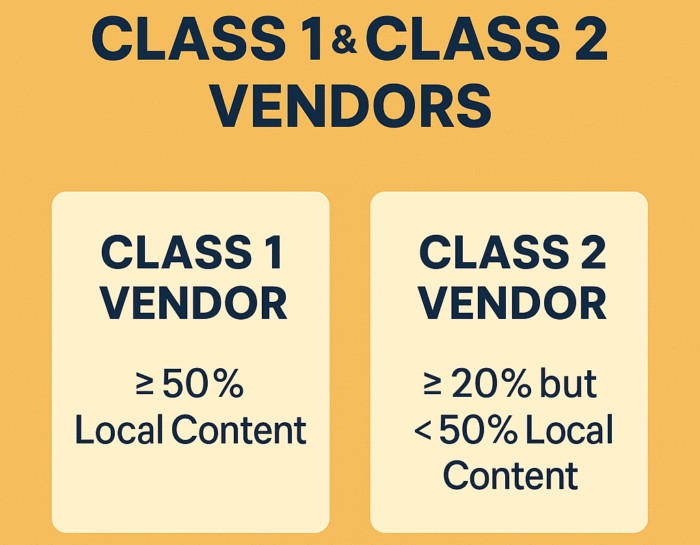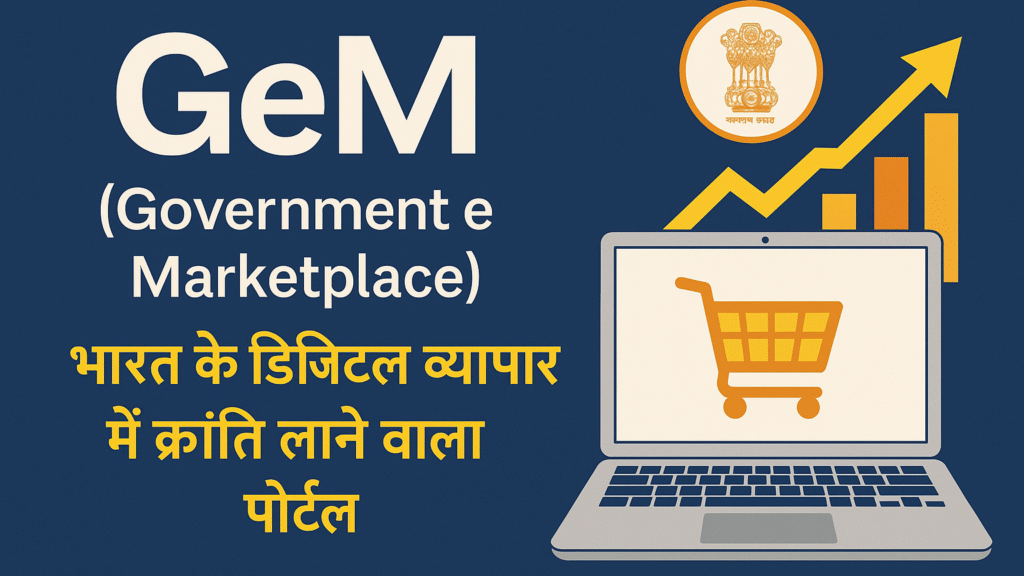What are Class 1 and Class 2 Vendors?
On GeM, vendors are categorized primarily into Class 1 and Class 2 based on the percentage of local content in the product or service they offer. This classification is defined under the Public Procurement (Preference to Make in India) Order, 2017, as amended by the Department for Promotion of Industry and Internal Trade (DPIIT).
Class 1 Vendor refers to a supplier or service provider whose goods, services, or works offered for procurement have a minimum local content of 50% or more. These vendors enjoy the highest preference in all government procurement processes.
Class 2 Vendor refers to a supplier or service provider whose products or services offer local content between 20% and 50%. While they are eligible to participate in government bids, they do not receive the same preferential treatment as Class 1 vendors when it comes to tender evaluation and award.
In comparison:
- Class 1 Vendors = ≥ 50% local content
- Class 2 Vendors = ≥ 20% but < 50% local content
This classification ensures that vendors contributing to the domestic economy are rewarded through preferential procurement policies.
Eligibility Criteria for Class 1 and Class 2 Vendors
To be recognized as a Class 1 or Class 2 vendor on GeM, businesses must meet specific eligibility criteria primarily focused on the percentage of local content and necessary certifications.
Local Content Requirement:
Local content refers to the value of goods or services that are locally produced in India, as a proportion of the total value of the product or service.
- Class 1 Vendors must have at least 50% local content.
- Class 2 Vendors need a minimum of 20% local content but less than 50%.
Certification through Self-Declaration:
Vendors are required to self-certify their local content percentage during product or service listing. This declaration is submitted online via the GeM portal and becomes a critical part of vendor validation and bid evaluation.
Verification and Audit Processes:
Although the declaration is self-certified, the GeM authorities reserve the right to audit and verify the accuracy of the claims. In case of false declarations or misrepresentation, vendors may face penalties, blacklisting, or removal from the platform. Therefore, it is essential for vendors to maintain transparent documentation and manufacturing records to support their claims.
Policy Framework Supporting Class 1 and Class 2 Vendors
The classification and preference policies for Class 1 and Class 2 vendors are not arbitrary but are grounded in a well-defined policy framework instituted by the Indian government to promote domestic industry.
Public Procurement (Preference to Make in India) Order, 2017:
Issued by the Department for Promotion of Industry and Internal Trade (DPIIT), this policy mandates that government buyers give preference to Class 1 vendors over others in public procurement. Class 2 vendors can only be considered if no suitable Class 1 vendor is available.
This policy aims to encourage manufacturing within the country, reduce import dependency, and ensure that taxpayers’ money supports Indian enterprises.
DPIIT Guidelines and Notifications:
Over time, DPIIT has issued amendments and clarifications to ensure the policy remains current with market conditions. These updates provide clear definitions, thresholds, and procedural guidance to vendors and buyers alike, strengthening the framework for fair and localized procurement.
Benefits of Being a Class 1 or Class 2 Vendor
GeM offers several strategic advantages for vendors classified under Class 1 and Class 2, especially in terms of procurement access and visibility.
Enhanced Visibility:
Class 1 vendors are prominently displayed in search results and recommendations on the GeM portal. This exposure significantly improves business prospects by increasing product or service discoverability among government buyers.
Preference in Bidding:
Class 1 vendors are given top priority in tender processes. Even in cases where price quotations are similar, Class 1 vendors are favored due to their higher local content. This policy ensures more business opportunities for domestic producers and service providers.
Access to Government Contracts:
Both Class 1 and Class 2 vendors gain access to a vast and consistent stream of government tenders. With over 50,000+ buyer organizations registered on GeM, the opportunity to scale and sustain businesses is immense.
These advantages make it highly worthwhile for vendors to ensure they meet the criteria for Class 1 or at least Class 2 classification.
How to Register as a Class 1 or Class 2 Vendor on GeM
Registering on the Government e-Marketplace as a Class 1 or Class 2 vendor is a streamlined but detail-oriented process. The portal is designed to promote ease of doing business, but vendors must ensure that they provide accurate and complete information.
Step-by-Step Registration Process:
- Visit the official GeM portal (https://gem.gov.in).
- Click on “Sign Up” and select the “Seller” option.
- Enter required business details such as PAN, Aadhaar, Udyam Registration (for MSMEs), and company name.
- Provide bank account details and mobile number linked with Aadhaar for verification.
- Upload the relevant product or service listings.
- During listing, declare your local content percentage to be categorized as Class 1 or Class 2.
- Submit self-declaration forms online to validate the classification.
Documents Required:
- PAN Card
- GST Registration Certificate
- Udyam Registration Certificate (for MSMEs)
- Local Content Declaration Form
- Product/Service Technical Specifications
- Bank Account Details with Cancelled Cheque
Common Pitfalls to Avoid:
- Providing inaccurate local content percentage.
- Skipping self-declaration uploads.
- Listing products without compliance documents.
- Delays in updating expired or outdated certifications.
By following the process diligently, vendors can successfully position themselves for preferred treatment under GeM’s procurement ecosystem.
Role of Make in India in Vendor Classification
The “Make in India” initiative is the backbone of the Class 1 and Class 2 vendor classification system. Introduced in 2014, the initiative seeks to transform India into a global design and manufacturing hub. It will help by promoting indigenous production and reducing import reliance.
Alignment with National Initiatives:
Vendor classification is directly aligned with “Make in India” by offering preferential treatment to those contributing significantly to local manufacturing. This ensures government procurement dollars are spent to empower Indian enterprises, generate employment, and drive GDP growth.
Boosting Domestic Manufacturing:
By favoring Class 1 vendors with ≥50% local content, the government incentivizes companies to enhance their local sourcing, establish local manufacturing units, and invest in Indian labor and infrastructure. Even Class 2 vendors, with their 20%-50% local content, contribute positively toward this goal.
The result is a robust ecosystem where businesses are encouraged to go local, innovate domestically, and scale with the help of government contracts.
Evaluation Criteria and Bid Participation Rules
Understanding how vendors are evaluated during bid processes is critical for maximizing success on the GeM platform.
How Class 1 & 2 Vendors Are Evaluated:
- Class 1 vendors are given first preference during bid evaluation.
- If Class 1 vendors meet all technical and financial requirements, Class 2 vendors are not even considered.
- Class 2 vendors are eligible only if no Class 1 vendor qualifies or participates.
Restrictions on Foreign and Non-Compliant Vendors:
Foreign companies or vendors failing to meet the minimum 20% local content are categorized as “Non-Classified” and may be barred from participating in certain tenders. This restriction is especially stringent in sectors of strategic importance like defense, public safety, and infrastructure.
These evaluation rules ensure that procurement decisions not only offer value for money but also support the broader economic objective of self-reliance.


